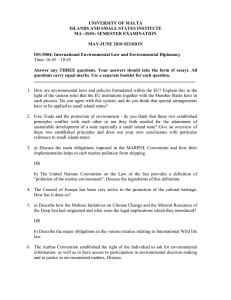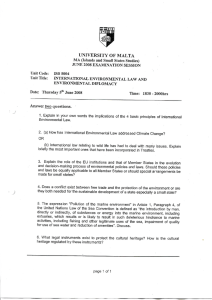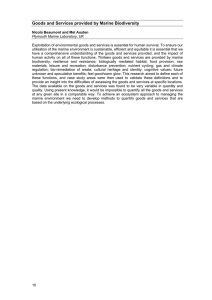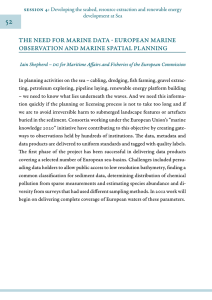The Marine Environment, Marine Living Resources and Marine
advertisement
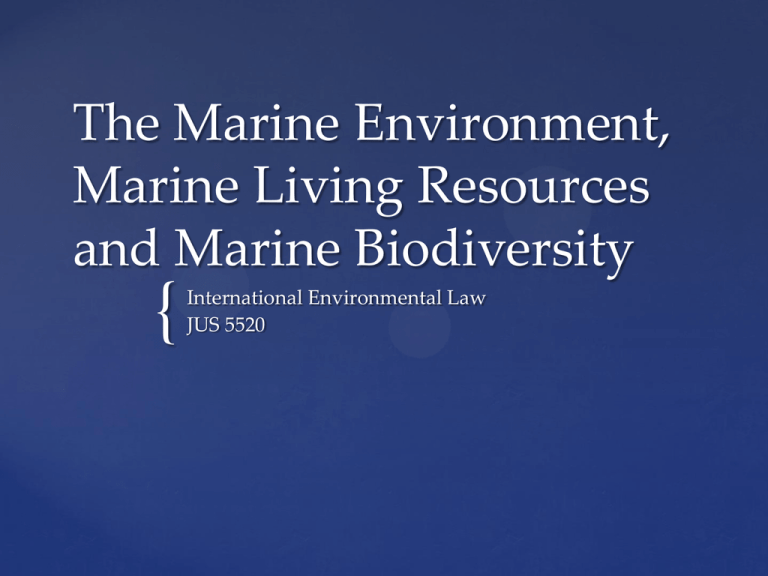
The Marine Environment,
Marine Living Resources
and Marine Biodiversity
{
International Environmental Law
JUS 5520
What are the key
challenges facing the
Marine Environment?
Pollution
Unsustainable fishing
Habitat destruction
Climate Change
Invasive species
Threats to the marine
environment come from
different sources:
Ships and the fishing
industry
Land based pollution
sources
Warming climate
Ocean acidification https://www.youtube.
com/watch?v=5cqCvc
X7buo&list=PLul7zT
U2HVOhgK6C8e2p5E
gcry07MPNEu
Climate change and the
oceans
QUESTION: How do
we regulate the use of
resources and the
protection of the
environment on the
high seas outside of the
jurisdiction of states?
Extended jurisdiction
of states?
Greater liability for
flag states?
Extensive
international
regulation of common
resources?
Regulation of the marine
environment
Terminology
As far back as 1893, an international arbitration tribunal gave an award in
the Pacific Fur Seal Arbitration. This concerned a dispute between the
United Kingdom and the United States as to the circumstances in which
the United States - a coastal State – could interfere with British fishing
activities on the high seas. This pitted interests of conservation against
interests of economic exploitation.
1926 – Preliminary Conference on Oil Pollution of Navigable Waters
1954 – Oil Pollution Convention
1958 – High Seas Fishing and Conservation Convention, Convention on
the Continental Shelf, Convention on the High Seas
The International Maritime Organisation (IMO) came into existence as the
International Maritime Consultative Organization (IMCO) on 17th March,
1958 when the Convention establishing the organisation came into force.
The development of marine environmental law was given impetus by the
Torrey Canyon incident in 1968, the Amoco Cadiz incidentin 1978 and
Exon Valdez in 1989.
1992 – Convention of the Protection of the Baltic, Convention on the
Protection of the Marine Environment of the North East Atlantic
A brief history
1969 – Intervention Convention, 1971 – Oil Pollution Fund
Convention
The 1972 United Nations Conference on the Human Environment
held in Stockholm marked the beginning of a distinctive area of
international law – international environmental law – and raised
concerns about the marine environment.
1972 - Convention on the Prevention of Marine Pollution by
Dumping Wastes and Other Matter (the London Convention),
Convention on the Prevention of Marine Pollution by Dumping by
Ships and Aircraft (Oslo Dumping Convention)
1973 – International Convention for the Prevention of Pollution
from Ships (MARPOL)
United Nations Convention on the Law of the Seas [UNCLOS] 10th
Dec. 1982, (entered into force on 16 November 1994) – stated in its
preamble that oceans are the common heritage of mankind.
A brief history continued
Law developing in response
to accidents https://www.youtube.com/w
atch?v=VaRdUHrUnBs
Principle cause of pollution,
however, is land based
sources
Marine environmental law
and marine accidents
Established in 1948
As a specialized agency of the United Nations, IMO is the global standard-setting
authority for the safety, security and environmental performance of international
shipping. Its main role is to create a regulatory framework for the shipping
industry that is fair and effective, universally adopted and universally
implemented.
Purposes of the Organization - Article 1(a) of the Convention: "to provide
machinery for cooperation among Governments in the field of governmental
regulation and practices relating to technical matters of all kinds affecting
shipping engaged in international trade; to encourage and facilitate the general
adoption of the highest practicable standards in matters concerning maritime
safety, efficiency of navigation and prevention and control of marine pollution
from ships.” Its mission has evolved from regulation of international shipping to
the current mission, described as "safe, secure, environmentally sound, efficient
and sustainable shipping through cooperation."
IMO and the Environment
IMO and protected areas /https://www.youtube.com/watch?v=HqOQoHXcRrk&index=11&list=UUoQbQEaEhVBywNRB-XsHOQ
International Maritime
Organisation (IMO)
Global instruments - United
Nations Convention on the Law of
the Sea
The primary instrument governing the Marine Environment in IEL http://www.un.org/depts/los/convention_agreements/texts/unclos/UNC
LOS-TOC.htm
Completed in 1982
Provides a framework – both spatial and functional
Stipulates the nature of different kinds of sovereign rights
Fundamental principles of ocean conservation
Widely supported (161 parties)
Criticised for its fragmented approach and failure to protect resources
outside of national jurisdiction
Creates a framework for issues of jurisdiction, fisheries and exploitation
of resources. Does it create a framework for marine protection? Marine
protected areas? Incorporation of environmental principles?
The States Parties to this Convention,
Prompted by the desire to settle, in a spirit of mutual understanding and cooperation, all
issues relating to the law of the sea …
Conscious that the problems of ocean space are closely interrelated and need to be
considered as a whole,
Recognizing the desirability of establishing through this Convention, with due regard for
the sovereignty of all States, a legal order for the seas and oceans which will facilitate
international communication, and will promote the peaceful uses of the seas and oceans,
the equitable and efficient utilization of their resources, the conservation of their living
resources, and the study, protection and preservation of the marine environment,
Bearing in mind that the achievement of these goals will contribute to the realization of a
just and equitable international economic order which takes into account the interests and
needs of mankind as a whole and, in particular, the special interests and needs of
developing countries, whether coastal or land-locked,
Desiring by this Convention to develop the principles … that the area of the seabed and
ocean floor and the subsoil thereof, beyond the limits of national jurisdiction, as well as its
resources, are the common heritage of mankind, the exploration and exploitation of which
shall be carried out for the benefit of mankind as a whole, irrespective of the geographical
location of States,
Believing that the codification and progressive development of the law of the sea achieved
in this Convention will contribute to the strengthening of peace, security, cooperation and
friendly relations among all nations in conformity with the principles of justice and equal
rights and will promote the economic and social advancement of all peoples of the world
UNCLOS Preamble
{
Maritime zones under UNCLOS
Definition of pollution in Art 1 - "pollution of the marine
environment" means the introduction by man, directly or indirectly,
of substances or energy into the marine environment, including
estuaries, which results or is likely to result in such deleterious effects
as harm to living resources and marine life, hazards to human health,
hindrance to marine activities, including fishing and other legitimate
uses of the sea, impairment of quality for use of sea water and
reduction of amenities.
Part II – Sovereignty of a coastal state extents to territorial sea – 12
nautical miles from the low water line.
Article 17 – right of innocent passage – Art 21 – state can adopt laws
relating to innocent passage on marine protection, management of
pollution, scientific research etc
(see also art 42 on transit passage)
Part XII – Protection and Preservation of the Marine Environment (see
hand-out)
What about the high seas? Articles 116 – 120 (see hand out)
Environmental provision in
UNCLOS
Regional arrangements
UNCLOS gaps to be filled by regional arrangements
We see in regional instruments greater incorporation of
environmental principles and move away from mere pollution
prevention
UNEP Regional Seas Programme 1974 http://www.unep.org/regionalseas/
“The Regional Seas Programme aims to address the accelerating
degradation of the world’s oceans and coastal areas through the
sustainable management and use of the marine and coastal
environment, by engaging neighbouring countries in comprehensive
and specific actions to protect their shared marine environment.”
“Today, more than 143 countries participate in 13 Regional Seas
programmes established under the auspices of UNEP: Black
Sea, Wider Caribbean, East Asian Seas, Eastern Africa,South Asian
Seas, ROPME Sea Area, Mediterranean, North-East
Pacific, Northwest Pacific,Red Sea and Gulf of Aden, South-East
Pacific, Pacific, and Western Africa.” – most consisting of various
conventions and protocols relating to subject specific issues such as
emergencies, dumping, fauna and flora etc
Regional arrangements:
OSPAR Convention
“15 Governments of the western coasts and catchments of Europe, together
with the EU, cooperate to protect the marine environment of the NorthEast Atlantic. It started in 1972 with the Oslo Convention against dumping.
It was broadened to cover land-based sources and the offshore industry by
the Paris Convention of 1974. These two conventions were unified, updated and extended by the 1992 OSPAR Convention. The new annex on
biodiversity and ecosystems was adopted in 1998 to cover non-polluting
human activities that can adversely affect the sea.” http://www.ospar.org/
Takes stronger measures than those envisioned by UNCLOS – such as the
prohibition on dumping at sea
New approach - Treats:
pollution from land-based sources
pollution for off-shore installations
pollution by dumping and incineration at sea
An annex and detailed rules for each of these.
Plays a major role in reducing marine pollution by hazardous
substances.
General obligation: States “shall … take all possible steps to
prevent and eliminate pollution”.
Principles:
the precautionary principle
the polluter pays principle
“sustainable management”
“latest technological developments and practices”
Minimum regulation: States can take stricter measures than
agreed pursuant to the convention.
Creation of the OSPAR Commission – powers to take legally
binding decisions, assess compliance
OSPAR cont
Marine Living
Resources and Marine
Biodiversity
The problem of
overfishing http://vimeo.com/4261954
5
FAO statistics and
monitoring http://www.fao.org/docre
p/015/i2389e/i2389e.pdf
Challenges of fish stock
management:
Migratory stocks
High seas
Lack of incentive to limit
fishing
Problem of communication
between science and policy
Marine Living Resources
•
•
•
1958 Convention on the Territorial Sea and the Contiguous Zone
and Convention on the Continental Shelf – sovereignty of the
coastal state over rights to living resources in the territorial sea and
continental shelf
1958 Convention of the High Seas – Freedom of the high seas
including freedom of fishing “to be exercised with reasonable regard
to the interests of other states”
1958 High Seas Fishing and Conservation Convention – requires
states to adopt measures for the conservation of marine resources
Marine Living Resources cont
•
1982 UNCLOS - Primary instrument.
•
•
•
•
•
•
Maritime zones governing marine living resources in and beyond
national jurisdiction.
Extended rights of coastal states by formalising legal status of the EEZ
(Art 56).
TAC must not result in endangerment of living resources “taking into
account bets scientific evidence available.” (Art 61)
Provisions on management of fisheries broadly reflect customary
international law.
Some protection for migratory species and marine mammals,
specifically through requirements of co-operation.
High seas – maintains freedom of all states to fish (Art 87) limited by
treaty obligations, rights of coastal states must be respected,
provisions concerning conservation must be respected (Art 116).
Marine Living Resources cont
•
1993 Compliance Agreement
•
•
•
•
•
Seeks to address the problem of “flags of convenience”
Details the obligations of flag states including not undermining conservation measures
Excludes vessels less than 24 metres
Has only received limited support
1995 Fish Stock Agreement
•
•
•
Applies to straddling fish stocks and highly migratory fish beyond areas of national
jurisdiction (with limited provision to conservation within areas of national jurisdiction)
Primary responsibility still falls on the flag state
Increased international conservation obligations including:
•
•
•
•
•
•
•
•
•
•
•
Obligations to adopt measures to ensure long term sustainability and promote optimum utilization
Use of best scientific evidence to maintain maximum sustainable yield
Apply precautionary approach
Assess impacts of fishing and other human activities and environmental factor
Protect biodiversity
Monitoring and surveillance
Emphasis on regional and sub-regional arrangements – limiting the right to fish in some instances
by requiring participation in regional organisations.
1995 Code of Conduct for Responsible Fisheries and 1999 Rome Declaration on the
Implementation of the Code of Conduct
Johannesburg Plan of Implementation 2002 – restore stock levels by 2015
Important role of the FAO and the Committee of Fisheries
Regional Instruments
Marine Living Resources cont
Case law – marine living resources
Pacific Fur Seal Arbitration 1893 – limits of jurisdiction to protect
marine animals and the absolute freedom to fish. Limitations of
the ‘flag state’ approach.
1972 Fisheries Jurisdiction case (ICJ) – Iceland decided to extend
its exclusive fishing zone to 50 nautical miles. Court denied
Iceland’s right to do so but said that Iceland had preferential
fishing rights. ICJ found the states must have respect the other’s
rights and needs and must have due regard for conservation
needs.
The WTO Appellate Body’s decision in the Shrimp Turtle case,
concerning the circumstances in which the United States was able
to impose conservation measures under its laws on shrimping
activities taking place in four Asian countries (October 1998)
International Tribunal for the Law of the Sea’s provisional measures
order in the Southern Blue-Fin Tuna case brought by Australia and
New Zealand against Japan, addressing Japan’s unilateral scientific
experimental fishing (August 1999). ITLOS prescribed provisional
measures pending the decision of an arbitral tribunal setting the
annual allocation at the level last agreed and stopping experimental
fishing, applying a precautionary approach. The arbitral tribunal
decided that it did not have jurisdiction to hear the claim. One of the
advantages of UNCLOS is the compulsory jurisdiction provision.
This provision was seen to be undermined by the decision in the
Southern Blue Fin Tuna Case.
Case law – marine living resources
Marine biodiversity
UNCLOS – Part XII (see handout)
Convention on Biological Diversity (CBD)
relationship between the CBD and UNCLOS?
Responsibility on states to ensure activities within their jurisdiction do
not cause damage to other states or areas beyond their jurisdiction (Art 3)
Jakarta Mandate on Marine and Coastal Biological Diversity 1995 – area
management, protected areas etc
Regional measures and some species specific interventions
= A piecemeal approach to marine biodiversity
Marine biodiversity
Marine Protected Areas in
the High Seas
UNCLOS – no legal impediment to establishing
MPAs in the high seas given the freedoms of
the high seas.
Some pioneering work to establish MPAs under
the OSPAR Convention – identified 8 potential
MPA sites – various barriers to this process.
IWC Whale sanctuary and other examples of
limited MPAs
Marine Protected Areas
World Database on Protected Areas - http://www.protectedplanet.net/
Less than 1 percent of the oceans are protected by MPAs
No single definition of MPA (although see the CBD) and little international regulation
UNCLOS and MPAs in the EEZ –
Case of Chagos Archipelago – The British Government established a MPA around the Chagos
Islands known as the Chagos Marine Protected Area in 2010. It is the world's largest fully
protected reserve, twice the size of Great Britain.
On December 1, 2010, WikiLeaks release a leaked US Embassy London diplomatic cable
dating back to 2009 which exposed British and US calculations in creating the marine nature
reserve. The cable relays exchanges between US Political Counselor Richard Mills and British
Director of the Foreign and Commonwealth Office Colin Roberts, in which Roberts "asserted
that establishing a marine park would, in effect, put paid to resettlement claims of the
archipelago’s former residents." Richard Mills concludes: “Establishing a marine reserve
might, indeed, as the FCO's Roberts stated, be the most effective long-term way to prevent
any of the Chagos Islands' former inhabitants or their descendants from resettling in the
[British Indian Ocean Territory].”
The Government of Mauritius initiated proceedings on 20 December 2010 against the UK
Government under the United Nations Convention on the Law of the Sea (UNCLOS) to
challenge the legality of the ‘marine protected area’. Mauritius argues that Britain breached a
UN resolution when it separated Chagos from the rest of the colony of Mauritius in the 1960s,
before the country became independent, and that Britain therefore doesn’t have the right to
declare the area a marine reserve and that the MPA was not compatible with the rights of the
Chagossians – ongoing http://www.theguardian.com/world/2014/apr/21/chagos-islandsdiego-garcia-base-court-ruling
On 11 December 2012, the European Court of Human Rights rejected Application Chagos
Islanders v. The United Kingdom, lodged originally in 2004, on the grounds that it was
inadmissible. The case concerns complaints made by the Chagos Islanders arising from their
eviction from the islands between 1967 and 1973.
Summing up: Key
questions
How are we regulating the marine
environment in the high seas? Is this regulation
adequate? How could it be regulated better?
How are we enforcing state obligations in the
high seas? Are courts effective? Do we need
more and better enforcement mechanisms?
Are states co-operating in the management of
marine resources and in the preservation of the
marine environment? Are the co-operative
mechanisms effective?
http://www.jus.uio.no/english/services/library/t
reaties/06/6-05/
IMO - http://www.imo.org/Pages/home.aspx
FAO - http://www.fao.org/fishery/en
UN Treaties – (for example Intervention
Convention https://treaties.un.org/doc/Publication/UNTS/V
olume%20970/volume-970-I-14049-English.pdf)
Resources
